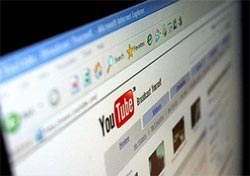It only takes a few minutes to understand why YouTube.com has skyrocketed to the status of “superstar of the Web” – featuring tear-jerking dance clips, a 79-year-old man reminiscing about his wife’s scolding, a bus battle in Hong Kong, and especially a caterpillar crawling… sluggishly across the floor.
In less than a year and a half, YouTube has transformed from an unknown name into the largest platform for “homegrown” video clips in the world. Every day, this website uploads over 100 million clips of all kinds. Undoubtedly, YouTube is currently the epicenter of online culture.
YouTube has become so famous that even traditional media have embraced it. NBC Television signed a partnership agreement with YouTube after discovering that clips from its comedy show “Saturday Night Live” posted on YouTube received more traffic than the original channel.
Irresistible Appeal
 |
| Source: AFP |
“YouTube is in a position similar to MySpace. It is the king of the online video domain,” said analyst Phil Leigh of Inside Digital Media. With 60% market share, YouTube has easily outpaced all giants like Yahoo, MSN, Google, and AOL.
Launched in February 2005 by a group of experienced warriors in Silicon Valley, YouTube’s traffic quadrupled in just the first five months of 2006.
By mid-July, it reached the milestone of 100 million video views per day, thanks to an array of extremely funny, quirky, and even outrageous video clips.
For example, a nearly ten-minute video capturing a heated argument in Cantonese titled “Hong Kong Bus Driver” and a six-minute enthusiastic dance by accidental performer Jud Laipply topped the “charts” of clips on YouTube with sky-high hit rates.
Thanks to this unexpected successful performance, Laipply became an overnight sensation. His clip attracted over 31 million views, becoming the “most popular” clip in YouTube’s history, surpassing tens of thousands of other clips.
Another extremely popular clip features the famous headbutt by player Zinedine Zidane. This clip inspired a slew of others that parodied it, making viewers laugh until they cried.
Changing Perceptions
Welcoming everyone to post clips, YouTube’s operational principle is incredibly simple. “Success comes from the humor and creativity of everyone involved,” Leigh said.
By simply opening a free account, anyone can easily upload a “homemade” clip to YouTube in less than 10 minutes. Viewers can search for videos by theme or style, and they can rate the clips.
“If you provide rich content, you attract a lot of viewers. With more viewers, you attract even more people to post content. It’s a closed-loop cycle,” said expert Scott Kessler of Standard and Poor.
The undeniable power of YouTube was demonstrated by its contract with NBC: Initially, the network insisted that YouTube remove all “Saturday Night Live” clips from its site, claiming it had “no rights to broadcast” them. However, NBC soon realized that YouTube had made their show exponentially more popular.
Thus, NBC decided to introduce a series of popular programs on YouTube, in exchange for links to YouTube appearing on NBC’s website.
The New King of Media?
What is noteworthy about YouTube is that this website does not just compile goofy, silly, purely entertaining video clips. Many people have turned to it to share creativity, journalistic ability, and even politicians have found ways to promote themselves through YouTube.
For instance, Democratic politician Nancy Pelosi has posted 116 clips to express her views, as well as those of other Democrats.
Wall Street views YouTube as a new media platform of the generation, similar to MySpace – the largest social networking site today – and Skype – the number one provider of free internet phone services globally.
“YouTube reminds me of Skype. Both are absolute leaders in their fields, both are very well-known brands, and both benefit from the Internet. They are favored for the simplicity of the technology they provide and attract a large number of active, loyal users…“
“Just look at how much money Skype has made from its business model. And Skype isn’t even as attractive as YouTube!” Kessler said.
Although no major players have yet expressed interest in purchasing YouTube, the New York Post has predicted the website’s value to be between $600 million and $1 billion.
Trọng Cầm





















































